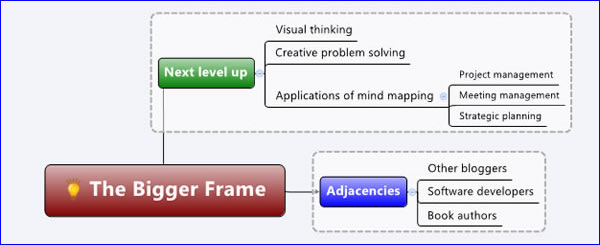Too often, as business owners and managers, we get stuck in our own myopia. In other words, we define what we do in a very narrow way. While focus is often good, it can also severely limit our vision of what else is possible, and therefore limit our business.
That’s why it makes sense to take a look at the “bigger frame” from time to time – the larger context within which you’re doing business. Investing the time to look beyond your little fenced-in parcel of the universe can reveal new ideas and opportunities for growth.
The bigger frame can take two forms; both are worthy of your exploration:
Adjacencies are those opportunities that are “next” to you, at the same level of the market in which you do business. For companies that manufacture physical products, this could include suppliers who provide you with components or raw materials that help you to create your products, or dealers who help you to sell it. What about products or services that enhance your customers’ experience with your products? Think add-ons, complementary products or ancillary services.
Adjacencies could also include competitors, with whom you could creatively partner to share complementary resources or find ways to make the experience of purchasing, owning and using both of your products better for all of the customers in your industry. Think about potential ways in which you could partner with these firms to add more value to your mutual customers.
The other bigger frame is”above” your firm. This is best understood by example. Imagine a trucking firm that said, “We’re not in the trucking business, we’re in the transportation business.” That simple change of frame may lead to opportunities to provide logistical and just-in-time warehousing services to manufacturers, or multi-modal partnerships with rail or shipping lines. See how that works?
If you’re a blogger or content creator, you really need to look at the bigger frame periodically, to help you keep your writing fresh and to attract new readers to your website. My experience is a case in point. After 4 years of writing the Mind Mapping Software Blog, I started to ask myself, “What else is there?” I started to think in terms of larger frames, the topics and concepts that surround mind mapping.
One of the terms I immediately focused upon was visual thinking. Mind mapping is a subset of the larger category of visual thinking. Its peers include diagramming, process mapping and creating sketch notes (hand-written notes with simple images that add emphasis and meaning). About a year ago, I started to incorporate posts into this blog that are focused on visual thinking, including resource lists, examples and book reviews. Many of the visual thinking principles I’ve posted about are directly applicable to mind mapping.
I’m convinced that incorporating this broader perspective has been a positive move for the Mind Mapping Software Blog, and has helped me to attract more readers to it.
Mind map your bigger frame opportunities
Not surprisingly, a mind map is an excellent tool to help you to visualize these potential opportunities. I created an example (above) to help you visualize one possible form it could take. Create your own, modeled after this one. Or do your own thing.
Don’t just stop with a few terms, like I did for this simplified example. Fully explore all of the possibilities, and then step back and evaluate them and focus in on one or two that are the most promising. Hint: You can use numerical map markers to rate your ideas.
Action steps
Why not invest some time exploring the areas that are adjecent to or above your product, service or information space? At the very least, seek out leaders in these areas and open up a dialogue. Find out what they’re struggling with and where they need help. Look for opportunities to share in content creation, marketing, sales and other potential areas of commonality.
I think you’ll be pleasantly surprised at how much removing these “blinders” can open you up to some fascinating new possibilities to grow your business!


Leave a Reply